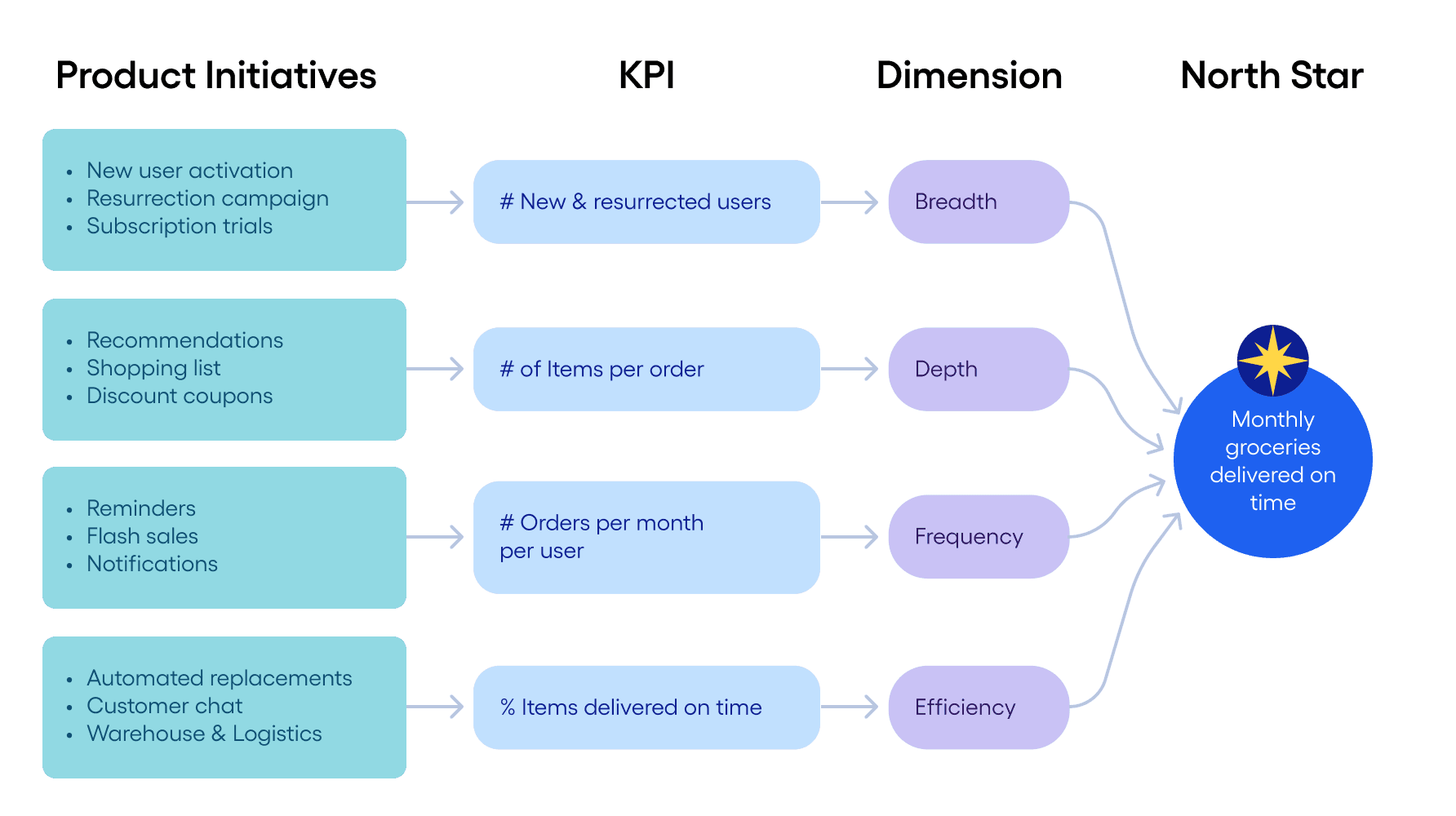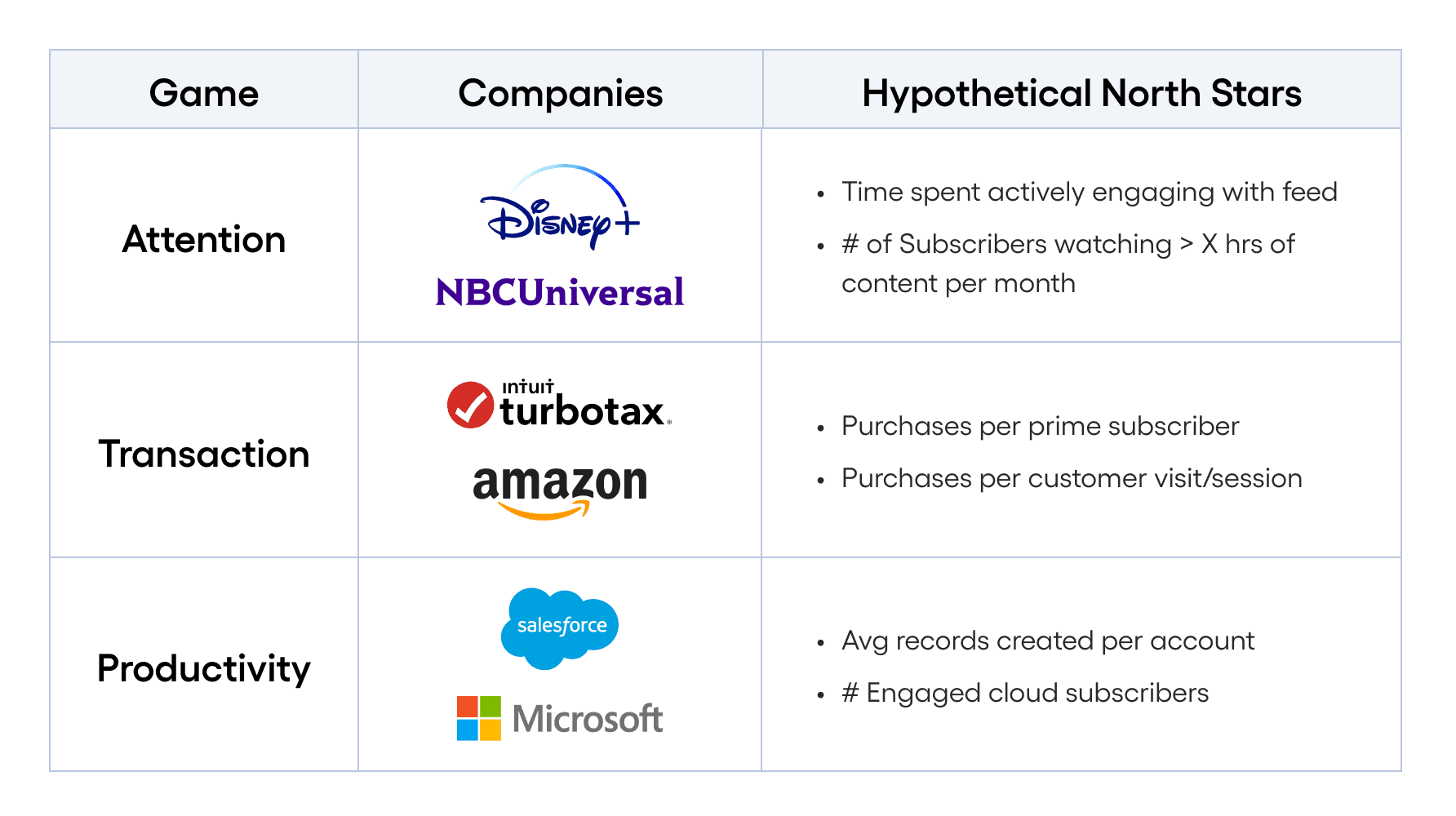Every Product Needs a North Star Metric: Here’s How to Find Yours
Get an introduction to product strategy with examples of North Star Metrics across industries.
The North Star Framework is a product management model based on a single metric—your North Star Metric—that best captures the value customers derive from your product. The North Star approach is an incredibly powerful product strategy framework, but when misunderstood or misused, can lead teams astray. This makes getting it right critical.
We believe that every product needs a North Star Metric, and we've seen the North Star Framework deliver game-changing benefits to teams and businesses—better alignment, clearer prioritization, and less wasted work.
Sound too good to be true? It's not. Let's explore the ins and outs of the North Star Metric, including:
- What it is and why it matters
- Characteristics of a good North Star Metric and examples
- Why a company should only have one North Star Metric
- Tips for selecting a good North Star Metric
- How to use your North Star to drive your product strategy
What’s your product’s North Star Metric?
Discover your product’s North Star Metric with our comprehensive guide.
What is a North Star metric, and why does it matter?
Your North Star Metric should be the key measure of success for your company's product team. It defines the relationship between the customer problems your product team is trying to solve and the revenue you aim to generate by doing so.

This serves three critical purposes in any company:
- It gives your organization clarity and alignment on what your product team needs to optimize and what they can trade off.
- It communicates your product organization’s impact and progress to the rest of the company—resulting in more support and acceleration of strategic product initiatives.
- Most importantly, it holds product teams accountable for an outcome.
In many companies, a product team's success is measured by how much they ship, not on their business impact. However, without an impact-driven product culture, it's hard to influence your business's destiny. Without a North Star, you can’t be a product-led growth company.
If you're responsible for your product’s strategy or execution, here are three questions to consider about your North Star Metric.
Question 1: What are the characteristics of a good North Star Metric?
A good North Star Metric consists of two parts:
- A statement of your product vision
- A metric that serves as a key measure of your current product strategy
A good North Star Metric also aligns to customer value, represents your product strategy, and is a leading indicator of success.

A good North Star Metric aligns to customer value
The North Star Metric you define should spring from a deep understanding of the actions within your product that provide realized value to your customer. Get as close to impact as possible.
In the product world, this is often referred to as finding your customer’s "aha moment.” If you can pinpoint the early actions that lead to your customers sticking around, you have an effective North Star Metric.
This means that “Daily Active Users” or “Registered Users” don't make good North Star Metrics. Though anecdotally useful, they say nothing about what your customers value about your product. When teams fail to connect customer value directly to their North Star Metric, they risk leading their business down the wrong path.
eCommerce North Star example
One of our customers, a Fortune 100 retailer, is trying to grow their mobile commerce business as a strategic priority for their future growth.
That team’s North Start Metric is “number of mobile orders delivered”. This metric captures someone ordering from their mobile app (their current strategy focus) and having a good experience (getting customer value) because their delivery was completed without payment issues, logistics complaints, or returns.
A good North Star represents your product strategy
If you’ve built a strong North Star, someone should be able to read it and understand your company’s product strategy and your vision—at least at a high level.
We generally recommend that your North Star is unique to your business, expressing your company’s and your product’s strategy and mission. However, some businesses have a mission that’s not particularly differentiated and a North Star that doesn’t feel unique—and that’s okay.
A good North Star is a leading indicator of success
A critical aspect of a good North Star Metric is that it's a leading indicator of future success. Lagging indicators like monthly revenue or average revenue per user (ARPU) don’t give you an early signal of product impact. They tell you what happened in the past rather than predicting future revenue. The further upstream of revenue and market capitalization you can get your metric, the more future impact you can drive.
B2B North Star example
If you’re running a subscription-based product, you might consider annual revenue from subscribers your key metric, but it’s a lagging indicator.
Instead, a subscription-based business could identify characteristics that correlate with a user who is likely to renew their subscription and then build a North Star around that. If a user frequently runs a certain report showing the status of their customers, does that correlate to renewing a subscription? Perhaps that’s a hint that your North Star may be related to the information in that report.
Similarly, if a SaaS company has a self-serve business model like that of Dropbox or Hubspot, their metric might be “trial accounts with >3 users active in week 1 .” This metric captures all the new, free accounts that are getting value and providing a signal of future trial conversion and subscription revenue being generated that the product team can predict and drive.
Facebook North Star example
In its early days, Facebook famously chose “# users adding seven friends in the first ten days” as their key metric. If you are interested in how to go about identifying those critical actions – here’s a detailed guide!
Question 2: Should a company only have one North Star Metric?
In most cases, the answer to this question is "yes." It’s unlikely that one product leader should manage more than one North Star. Certainly, larger enterprises with multiple or diverse divisions, product management and development departments, and customer bases could have different North Star Metrics, each with its own inputs.
But if a team contributes to a single profit and loss (P&L) statement with a single product development department and a single product or even a product portfolio that serves a single customer base, we recommend having a single North Star with one metric and its inputs per product.
Inputs are a set of three to five influential, complementary factors that you believe most directly affect your North Star Metric and that your team can directly influence through your product.
One heuristic we've found helpful when teams are determining inputs is considering breadth, depth, frequency, and efficiency. The inputs to a North Star Metric often follow this pattern, which you can easily adapt to different contexts.
Below is an example of a North Star tree for a grocery ordering and delivery app. The tree ties together a dozen different product initiatives together into a single framework to drive each dimension of the North Star Metric forward.

Using this framework, every team knows what their inputs are and how they contribute to the North Star. This enables everyone to make the right trade-offs and resourcing decisions.
Question 3: How do you select a good product North Star?
The first step in choosing the right North Star metric for your product is to figure out what "game" your business is playing. This game is your core customer engagement model.
Based on our research of products and analysis of over one trillion behavioral data points every month, Amplitude has categorized digital products into one of three possible games.
1. The Attention Game: How much time are your customers willing to spend in your product?
2. The Transaction Game: How many transactions does your user make on your platform?
3. The Productivity Game: How efficiently and effectively can someone get their work done in your product?
When we share this framework with product managers, their first reaction is often, “All three games are super important to me.” However, your product team needs to decide on the game your business is playing so they can focus on winning it. Focusing on one game is critical to defining a solid product strategy and North Star Metric.
Below are some examples of companies playing each of these three games and what their product North Star Metrics could be. You will notice that companies playing the same game can have radically different North Stars because it reflects their unique product strategy.

For example, while Facebook and Netflix both play the attention game, their business models are radically different. Facebook’s revenue is proportional to the amount of feed engagement and ad revenue generated. Meanwhile, Netflix has a subscription model and a fixed (but ever-growing) amount of content. This means their North Star should maximize subscribers rather than the total time spent watching content.
Similarly, Amazon Retail and Walmart might have very different North Stars despite being players in the same transaction game. Amazon's subscription model gives them loyalty and visibility into customer lifetime value. So, they're likely optimizing for the number of Prime subscribers and the value they generate. Walmart, on the other hand, is a cost leader and likely focuses on the wallet share of their customer for every visit.
Salesforce aims to be the central source of truth for customer records in B2B companies and using AI to improve sales decision making is a strategic focus. Their North Star might be less focused on user adoption and more focused on the amount of customer data they store for their accounts. Unlike that model, the Adobe Creative Cloud likely focuses on individual subscribers and driving enough engagement to ensure continued subscription.
Use the North Star Framework to drive product strategy
You can use the North Star Framework to drive your product strategy and create an impact-driven organization. Adopting this approach puts you on the path towards becoming a product-led company.

What we like most about the North Star Framework is how it inspires valuable conversations. To identify, design, and implement your North Star, your teams must step away from screens, Jira tickets, and status updates, and spend time deeply engaged with one another—sharing ideas and learning.
This blog only scratches the surface on the North Star Metric and Framework. We've put together a series of North Star resources for you. The best place to start and for more tips, check out our North Star Playbook where we dig deeper on how to define your North Star Metric as well as:
- Fixing North Star Metric issues and avoiding traps.
- Making the North Star Framework stick in your organization.
- When to change your North Star Metric.
- Putting Your North Star Metric into action by connecting it to your work through levels of bets, incorporating into your roadmaps, and more.

Julia Sholtz
Former Group Product Marketing Manager, Amplitude
Julia is a former product marketer at Amplitude. She focuses on go-to-market solutions for enterprise customers.
More from Julia





